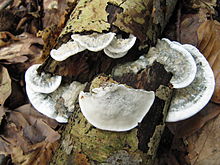Blue juice porling
| Blue juice porling | ||||||||||||
|---|---|---|---|---|---|---|---|---|---|---|---|---|

Blauender Saftporling ( Cyanosporus caesius ) |
||||||||||||
| Systematics | ||||||||||||
|
||||||||||||
| Scientific name | ||||||||||||
| Cyanosporus caesius | ||||||||||||
| ( Schrad. ) McGinty |
The blue end or Blue Saftporling ( Cyanosporus caesius , Syn. : Postia caesia , Oligoporus caesius , Spongiporus caesius ) is a species of fungus from the family of Stielporlingsverwandten .
features
Macroscopic features
The fruiting body is console-shaped and does not form a stem. It is 2–6 cm tall and has a felt-shaggy top. It is whitish in color and has blue areas that can partially or completely cover the surface. Touched areas also turn blue. There are small bluish white pores on the underside. At first they are irregularly rounded, and finally torn open like a labyrinth. The spore powder appears a little bluish. The edge of the hat is relatively sharp. The meat is soft-fibred and juicy and watery. It is colored white, but often streaked with a bluish tinge.
Microscopic features
The spores are colorless, smooth and often have two small drops of oil; they measure 4–5.5 × 1.5–2 µm.
Species delimitation

The Blauende Saftporling is characterized by its clear blue color and its growth mainly on softwood. The almost blue sap sporling ( Cyanosporus subcaesius ) looks similar . It is a little weaker in color and grows primarily on hardwood. However, it can only be identified with certainty by the somewhat narrower spores (4–5.5 × 1–1.5 µm) without oil droplets.
Ecology and phenology
The Blauende Saftporling is mainly found in spruce, pine and mixed conifer forests, in corresponding near-natural stands as well as in spruce-fir and spruce-fir-beech forests. It is only found occasionally in other collections. There it grows on dead and injured trunks (preferably on the trunk bases there) and on larger branches. In addition, the fungus can often be found on stored wood. The colonized substrate is in the late initial to the final phase of the decomposition. The host spectrum includes softwood, in 80% of the cases spruce . Hardwood is rarely colonized.
The fruiting bodies appear from the end of July. However, spore formation does not start until autumn, when the mean temperature has fallen below 10 ° C. The process ends about 8-10 weeks later with the onset of permanent frost. Sometimes overgrown specimens can still be observed until fruiting bodies have formed again.
distribution
The blue juice porling is in the Holarctic in North America (Canada, USA, Mexico), Europe (incl. Madeira , Azores ), North Africa (Morocco) and Asia (Asia Minor, Caucasus, Siberia, China, Korea, Japan) as well as in Central and South America (Jamaica, Argentina), Central Africa (Kenya, Tanzania) and New Zealand common. In Europe it is known from almost every country, but is apparently absent in Iceland and Greece. The area extends from the Mediterranean to the Hebrides and in Norway to the 70th parallel. To the east, the deposits extend to the Urals and the Caucasus .
In Germany, the fungus is widespread from the coastal regions to the highlands of the low mountain ranges. It was able to spread mainly through the conversion from natural forests to managed coniferous forests or their expansion to the locations in the hills and lowlands.
swell
literature
- German Josef Krieglsteiner (Ed.): The large mushrooms of Baden-Württemberg . Volume 1: General Part. Stand mushrooms: jelly, bark, prick and pore mushrooms. Ulmer, Stuttgart 2000, ISBN 3-8001-3528-0 , p. 549 ff.
Individual evidence
- ↑ LL Shen, M. Wang, JL Zhou, JH Xing, BK Cui: Taxonomy and phylogeny of Postia. > Multi-gene phylogeny and taxonomy of the brown-rot fungi: Postia (Polyporales, Basidiomycota) and related genera. 2019, accessed on August 12, 2020 .
- ↑ a b Ewald Gerhardt: FSVO manual mushrooms . 4th edition. BLV, Munich 2006, ISBN 978-3-8354-0053-5 , p. 451 .
Web links
- Blauer Saftporling on the website of the mushroom association of the Baden region